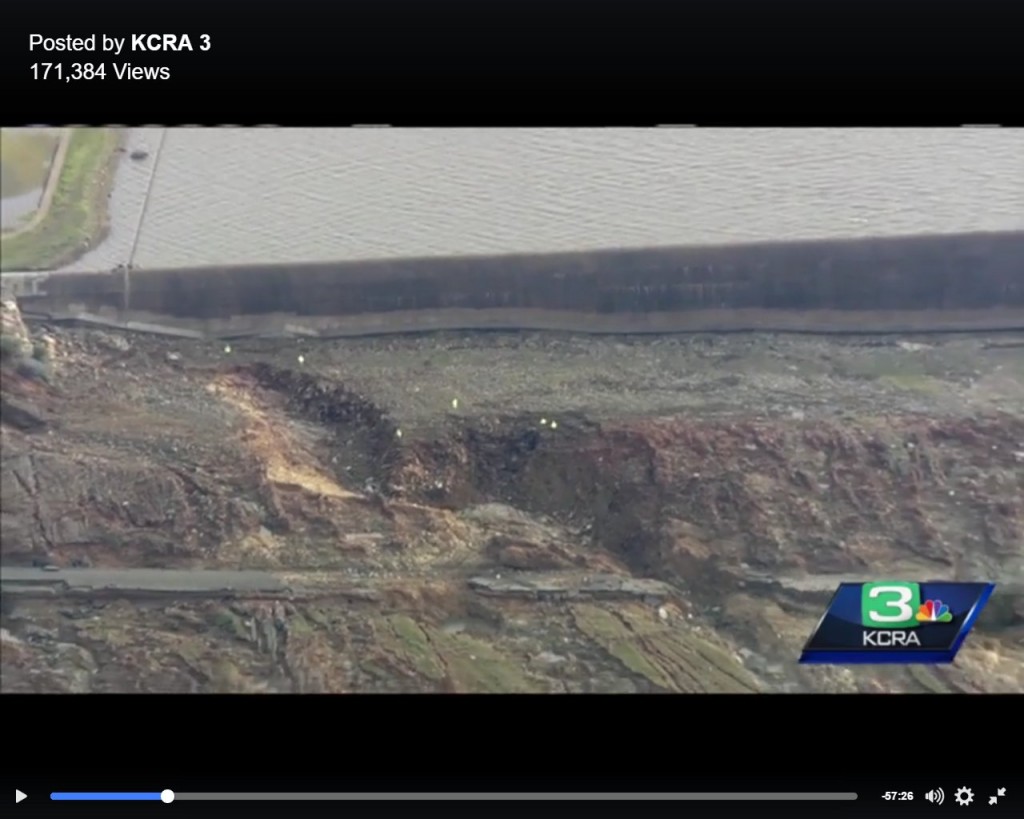Last night, over 100,000 people were forced to evacuate the towns immediately below California’s Oroville Dam, the tallest in the United States and the second-largest reservoir in California. Turns out all the rain Californians were begging for have now created a potentially horrific catastrophe.
To recap, the reservoir has finally been at peak capacity with all the recent rains. But the main spillway ended up with a giant sinkhole towards the bottom, which created the danger of further erosion and weakening if more water were to be released. Meanwhile, the auxiliary spillway — basically a concrete lip above an earthen hillside — had never been used in the dam’s 50-year-history.
And yesterday, on the first day that it was tested, it began to fail. See this picture from the local news of the giant fissure carved out below the concrete lip in just one day of use:
 Those yellow dots in the photo? Those are people.
Those yellow dots in the photo? Those are people.
Last night, officials were concerned about the imminent collapse of the auxiliary spillway, which meant a 30-foot breach of rushing water down towards Sacramento. The breach could lead, in a worst-case scenario, to the entire hillside getting washed out, draining the entire reservoir in a colossal flash flood.
In short, it could be the worst environmental disaster California has seen.
First, the good news: the immediate threat of spillway failure is now past. Officials are draining the reservoir like crazy, and so far the sinkholed spillway seems to be holding up okay.
But the bad news is that more rain is coming on Thursday and beyond, meaning the dam operators are in a race against time.
It’s hard to overstate how terrible failure of this dam would be. Obviously, hundreds of thousands of people are already affected, having had to rush out of their homes and book motel rooms or stay in shelters, not knowing if or when they can return to their lives and belongings. If major flooding does occur — or worse, total failure — all these towns will be wiped out, and it could even inundate Sacramento downstream.
Long term, the dam is the prime source of water (61%) for the California State Water Project, which supplies water to Southern California and the Bay Area, as well as Central Valley farmers. Losing that reservoir would likely put those parts of the state in an extreme water shortage situation for the long term.
It also has energy implications, as the hydropower generated by the reservoirs in this part of the state equals 2.2 billion kilowatt hours per year — making up a third of the total power generated by the statewide system.
The crisis in Oroville is both a natural and man-made disaster, with significant implications for long-term policy. It’s a natural disaster because of all of the recent rains that have overwhelmed the reservoir system and stressed the infrastructure. This trend will likely continue in an era of climate change, with more severe droughts punctuated by heavy rainfall and runoff from what used to come down as snow.
But it’s definitely a man-made disaster, too. Not least of which, officials were asked by environmental groups back in 2005 to pave the auxiliary spillway, out of concern for exactly this situation arising. As Paul Rogers of the San Jose Mercury News reports though, those officials denied the request, apparently out of an unwillingness to pay the tens of millions needed to perform the work.
From a policy perspective, the dam crisis has a number of implications:
- It reminds us once again that U.S. infrastructure is badly in need of repair and replace. The big wave of projects following World War II are now reaching the end of their useful lives or are in need of major upgrades, as the dam now symbolizes.
- Dam failure could potentially undermine the case for more dam projects going forward. In other words, what Fukushima did to nuclear power could now be happening to dams. The public may not want more dams to be built after this crisis.
- Most hopefully, it could bolster the case for more responsible and cost-effective means of dealing with water shortages, such as more water recycling, conservation measures, and storage in recharged groundwater aquifers rather than on the surface.
In the meantime, let’s hope state officials can stabilize the dam and release enough water, and that mother nature cooperates by bringing more slow-melting snow to the area rather than flooding rainwater.
9 thoughts on “The Oroville Dam Crisis & Policy Implications”
-
Pingback: Why the dangerous situation at Oroville Dam should be a wake-up call – FAEFABULA
-
Pingback: Why the dangerous situation at Oroville Dam should be a wake-up call – Munduscultura
-
Pingback: The crisis at Oroville Dam, explained – FAEFABULA
-
Pingback: The crisis at Oroville Dam, explained – Munduscultura
-
Pingback: The crisis at Oroville Dam, explained - Fullact Trending Stories With The Laugh Mixture
-
Pingback: The Oroville Spillway Failures: An Excuse For More Unnecessary Dam Building? | Ethan Elkind
-
Pingback: Why Should People in the Mississippi River Basin Care about the Oroville Dam? | River Life
-
Pingback: Climate Change And Infrastructure Spending — Press Briefing Audio | Ethan Elkind
-
Pingback: The crisis at Oroville Dam, explained ⋆ Epeak . Independent news and blogs
Comments are closed.


